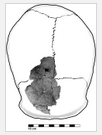María Dolores Garralda, Bruno Maureille, Bernard Vandermeersch
Source -http://www.sciencedirect.com/science/article/pii/S0047248414000037
Journal of Human Evolution
Abstract

The site of Marillac (Charente, France) has yielded an important stratigraphic sequence containing numerous Neandertal remains (some of them with peri-mortem manipulations) from lithofacies 2 (Quina Mousterian). This level has been correlated with MIS 4 and is associated with a TL date of 57,600 ± 4600 years BP (before present).
The study of one of the cranial fragments (Marillac 3) revealed a grade 2 or Type B Hyperostosis frontalis interna (HFI), remodelling and altering the internal table of the thick frontal bone. This pathology has been analysed macroscopically together with radiography and sections made using a microscanner and a scanner. The development of the HFI is compared with published evidence for Sangiran 3 (Homo erectus), two other Neandertals (Forbes' Quarry and Shanidar 5), and several archaeological samples. Forbes' Quarry seems to display more advanced HFI than either Shanidar 5 or Marillac 3. The three Neandertals may be considered mature individuals (≥40 years) and it seems likely that the aetiology of this pathology may be associated with hormonal alterations, as has been suggested for past and extant populations.
While the prevalence of HFI in contemporary post-menopausal women is well documented, the identification of HFI amongst males from several archaeological samples (Neanderthals, Ancient Egypt, Syrian Bronze Age or the Anasazi), with different stages of development, confirm that the pathology affected both sexes in past populations. Additional data and research are still needed to elucidate the etiopathogenesis of this illness and to better understand the relationship between environmental factors and their possible influences/consequences for the development of metabolic disorders in prehistoric populations.
